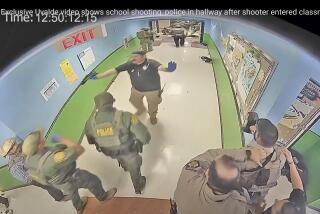Looking at Violence: 2 Reactions
ORANGE — Outside Cerro Villa Middle School last month, students and reporters faced off on the sidewalk, talking and furiously taking notes about a mall shooting that left one of the school’s students dead and another charged with her murder.
Some students pushed through the crowd quickly, eager to avoid the crush. But others, many of whom claimed close friendship to either the suspect or the dead girl, lingered long, savoring the attention and coolly discussing tragic events less than 24 hours old.
In the spring of 1987, I had witnessed a chillingly similar scene. I was among the mob of reporters who descended on Bergenfield High School in Bergenfield, N.J., after four students locked themselves inside a garage, turned on their car’s engine and killed themselves.
But where Bergenfield and its high school were catapulted into paroxysms of grief, self-examination and anger toward the media, last month’s murder seemed to leave few of the same scars. Why, just two years and 3,000 miles apart, did one tragedy tear so deeply at a community and another seem simply to waft over it?
Answers are hard to come by and are, of course, speculative. Still, educators at the two schools pondered the question last week, and were struck by the eerie parallels between the two incidents and the odd differences in the way their communities coped with them.
“That was a very tough time for these students,” said Lance Rozsa, principal of Bergenfield High School. “It really wasn’t until the next school year that things were pretty much back to normal, and then, on the anniversary, the media came back and some of it resurfaced.”
At Cerro Villa, the wounds already appear to be healing, aided by the holiday break, which helped distract students from the killing. But some students were more affected than they let on publicly, Principal Ralph Jameson said, and some may be hurting more deeply than even they realize.
“Sometimes you are placed in a situation where you are under stress and a reporter approaches you, and it’s a natural reaction to cover up your emotions,” Jameson said. “They could still experience a delayed reaction.”
Yet at least to the outside observer, few students at Cerro Villa reacted as strongly as their Bergenfield counterparts. At Cerro Villa, they ambled up to the cameras, chatted with reporters, stayed as long as there were people to take down what they said. In Bergenfield, they stayed on their side of the street--which reporters were barred from crossing--and lobbed eggs at the media pack across the way.
“It’s an interesting comparison,” Jameson said. “I think some of the different reactions may be based on the difference between a suicide and a murder.”
Indeed, the Bergenfield students and community seemed particularly racked by the wrenching mixture of grief and guilt that accompanies a suicide. The few students who did speak to reporters talked of wishing they had seen the signs in their friends before it was too late. In the most ghoulish twist of all, several days after the suicide, two more youngsters broke into the same garage and tried to kill themselves.
In the case of the Cerro Villa shooting, young people were left with the loss of their friends--one to jail and one to death--but they were not forced to ask themselves what they could have done to stop it. It was out of their hands, a tragic slip-up but not really a cause for deep self-examination.
The age of the students could also explain some differences in the way they reacted. Younger students may not fully grasp the significance of the deaths, and they may also be more eager to cooperate with reporters than high school students, who are more likely to view a prying collection of adults as a menacing, contemptible presence.
The most unnerving explanation, though, is that violence and murder have become so commonplace that they may not always shock youngsters any more, even when it happens to someone they know.
“Unfortunately, there may be a little element of students getting used to killing,” Rozsa said. “Killing happens, it happens all the time, on television and in life. Thank God it doesn’t happen more, but students may just not be as moved by a murder as they once were.”
More to Read
Sign up for Essential California
The most important California stories and recommendations in your inbox every morning.
You may occasionally receive promotional content from the Los Angeles Times.










